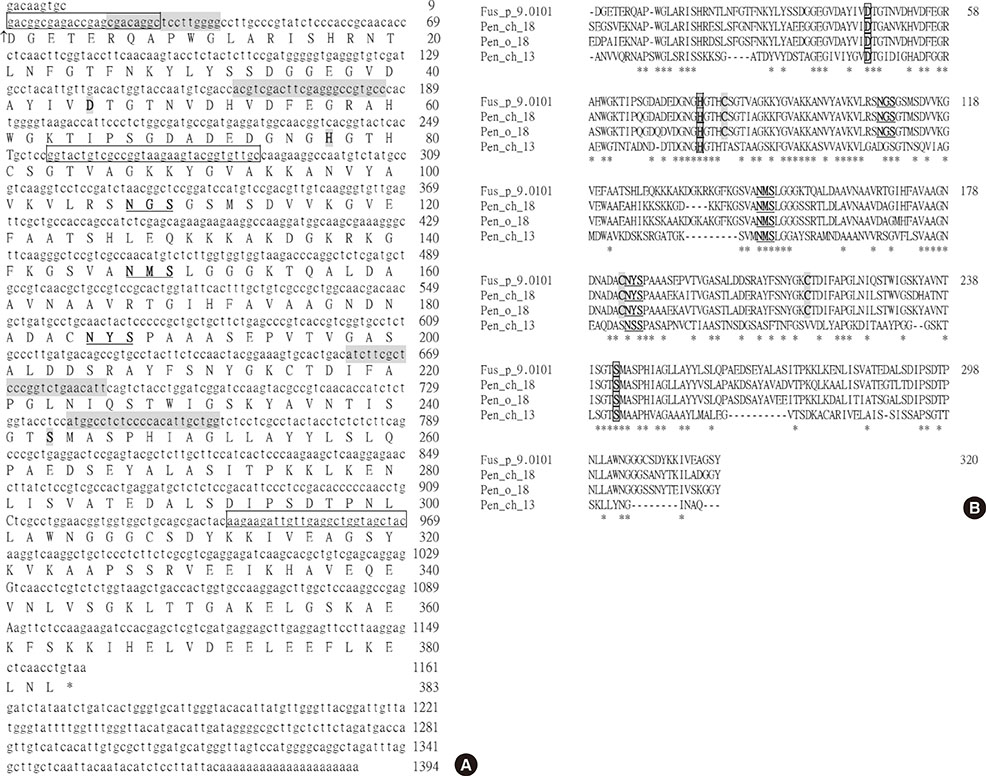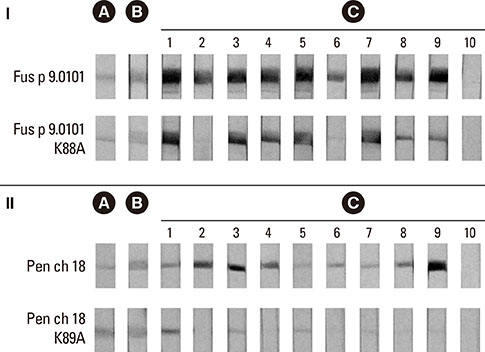Allergy Asthma Immunol Res.
2016 Sep;8(5):438-444. 10.4168/aair.2016.8.5.438.
Vacuolar Serine Protease Is a Major Allergen of Fusarium proliferatum and an IgE-Cross Reactive Pan-Fungal Allergen
- Affiliations
-
- 1Department of Obstetrics and Gynecology, Taipei Veterans General Hospital and Institute of Clinical Medicine, National Yang-Ming University, Taipei, Taiwan, R.O.C.
- 2Department of Medical Research, Taipei Veterans General Hospital, Taipei, Taiwan, R.O.C. hdshen@vghtpe.gov.tw
- 3Department of Pediatrics, Taipei Veterans General Hospital and National Yang-Ming University, Taipei, Taiwan, R.O.C.
- KMID: 2295153
- DOI: http://doi.org/10.4168/aair.2016.8.5.438
Abstract
- PURPOSE
Fusarium species are among prevalent airborne fungi and causative agents of human respiratory atopic disorders. We previously identified a 36.5-kDa F. proliferatum component recognized by IgE antibodies in 9 (53%) of the 17 F. proliferatum-sensitized atopic serum samples. The purpose of this study is to characterize the 36.5-kDa allergen of F. proliferatum.
METHODS
Characterization of allergens and determination of IgE cross-reactivity were performed by cDNA cloning/expression and immunoblot inhibition studies.
RESULTS
Based on the finding that the 36.5-kDa IgE-binding component reacted with the mouse monoclonal antibody FUM20 against fungal vacuolar serine protease allergens, the cDNA of F. proliferatum vacuolar serine protease (Fus p 9.0101) was subsequently cloned. Nine serum samples from respiratory atopic patients with IgE binding to the vacuolar serine protease allergen of Penicillium chrysogenum (Pen ch 18) also showed IgE-immunoblot reactivity to rFus p 9.0101. The purified rFus p 9.0101 can inhibit IgE and FUM20 binding to the 36.5-kDa component of F. proliferatum. Thus, a novel and important Fus p 9.0101 was identified. The rPen ch 18 can inhibit IgE binding to Fus p 9.0101. It indicates that IgE cross-reactivity between Fus p 9.0101 and Pen ch 18 also exists. Furthermore, neither rFus p 9.0101 K88A nor rPen ch 18 K89A mutants inhibited IgE binding to rFus p 9.0101. Lys88 was considered a critical core amino acid in IgE binding to r Fus p 9.0101 and a residue responsible for IgE cross-reactivity between Fus p 9.0101 and Pen ch 18 allergens.
CONCLUSIONS
Results obtained from this study indicate that vacuolar serine protease may be a major allergen of F. proliferatum and an important IgE cross-reactive pan-fungal allergen, and provide important bases for clinical diagnosis of fungal allergy.
MeSH Terms
Figure
Reference
-
1. Sharpe RA, Bearman N, Thornton CR, Husk K, Osborne NJ. Indoor fungal diversity and asthma: a meta-analysis and systematic review of risk factors. J Allergy Clin Immunol. 2015; 135:110–122.2. Twaroch TE, Curin M, Valenta R, Swoboda I. Mold allergens in respiratory allergy: from structure to therapy. Allergy Asthma Immunol Res. 2015; 7:205–220.3. Esch RE. Manufacturing and standardizing fungal allergen products. J Allergy Clin Immunol. 2004; 113:210–215.4. Jeong KY, Lee JH, Kim EJ, Lee JS, Cho SH, Hong SJ, et al. Current status of standardization of inhalant allergen extracts in Korea. Allergy Asthma Immunol Res. 2014; 6:196–200.5. Shen HD, Tam MF, Chou H, Han SH. The importance of serine proteinases as aeroallergens associated with asthma. Int Arch Allergy Immunol. 1999; 119:259–264.6. Chou H, Lai HY, Tam MF, Chou MY, Wang SR, Han SH, et al. cDNA cloning, biological and immunological characterization of the alkaline serine protease major allergen from Penicillium chrysogenum. Int Arch Allergy Immunol. 2002; 127:15–26.7. Shen HD, Chou H, Tam MF, Chang CY, Lai HY, Wang SR. Molecular and immunological characterization of Pen ch 18, the vacuolar serine protease major allergen of Penicillium chrysogenum. Allergy. 2003; 58:993–1002.8. Shen HD, Lin WL, Tam MF, Chou H, Wang CW, Tsai JJ, et al. Identification of vacuolar serine proteinase as a major allergen of Aspergillus fumigatus by immunoblotting and N-terminal amino acid sequence analysis. Clin Exp Allergy. 2001; 31:295–302.9. Shen HD, Tam MF, Tang RB, Chou H. Aspergillus and Penicillium allergens: focus on proteases. Curr Allergy Asthma Rep. 2007; 7:351–356.10. Chou H, Tam MF, Lee LH, Chiang CH, Tai HY, Panzani RC, et al. Vacuolar serine protease is a major allergen of Cladosporium cladosporioides. Int Arch Allergy Immunol. 2008; 146:277–286.11. Chou H, Wu KG, Yeh CC, Tai HY, Tam MF, Chen YS, et al. The transaldolase, a novel allergen of Fusarium proliferatum, demonstrates IgE cross-reactivity with its human analogue. PLoS One. 2014; 9:e103488.12. Lin WL, Chou H, Tam MF, Huang MH, Han SH, Shen HD. Production and characterization of monoclonal antibodies to serine proteinase allergens in Penicillium and Aspergillus species. Clin Exp Allergy. 2000; 30:1653–1662.13. Sams JT, Smith RE. Cross-antigenicity of common mold antigens. Ann Allergy. 1968; 26:55–60.14. Prince HE, Morrow MB. Skin reaction patterns to dematiaceous mold allergens. Ann Allergy. 1971; 29:535–538.15. Cheng TT, Tam MF, Chou H, Tai HY, Shen HD. Lys89, Lys90, and Phe91 are critical core amino acid residues of the Pen ch 18 major fungal allergen recognized by human IgE antibodies. Biochem Biophys Res Commun. 2008; 375:671–674.16. Shen HD, Wang CW, Lin WL, Lai HY, Tam MF, Chou H, et al. cDNA cloning and immunologic characterization of Pen o 18, the vacuolar serine protease major allergen of Penicillium oxalicum. J Lab Clin Med. 2001; 137:115–124.17. Moehle CM, Tizard R, Lemmon SK, Smart J, Jones EW. Protease B of the lysosomelike vacuole of the yeast Saccharomyces cerevisiae is homologous to the subtilisin family of serine proteases. Mol Cell Biol. 1987; 7:4390–4399.18. Nebes VL, Jones EW. Activation of the proteinase B precursor of the yeast Saccharomyces cerevisiae by autocatalysis and by an internal sequence. J Biol Chem. 1991; 266:22851–22857.19. Frederick GD, Rombouts P, Buxton FP. Cloning and characterisation of pepC, a gene encoding a serine protease from Aspergillus niger. Gene. 1993; 125:57–64.20. Shen HD, Chua KY, Lin WL, Hsieh KH, Thomas WR. Characterization of the house dust mite allergen Der p 7 by monoclonal antibodies. Clin Exp Allergy. 1995; 25:416–422.21. Chou H, Tam MF, Lee SS, Tai HY, Chang CY, Chou CT, et al. A vacuolar serine protease (Rho m 2) is a major allergen of Rhodotorula mucilaginosa and belongs to a class of highly conserved pan-fungal allergens. Int Arch Allergy Immunol. 2005; 138:134–141.22. Gupta R, Sharma V, Sridhara S, Singh BP, Arora N. Identification of serine protease as a major allergen of Curvularia lunata. Allergy. 2004; 59:421–427.23. Tai HY, Tam MF, Chou H, Peng HJ, Su SN, Perng DW, et al. Pen ch 13 allergen induces secretion of mediators and degradation of occludin protein of human lung epithelial cells. Allergy. 2006; 61:382–388.24. Kurup VP, Xia JQ, Shen HD, Rickaby DA, Henderson JD Jr, Fink JN, et al. Alkaline serine proteinase from Aspergillus fumigatus has synergistic effects on Asp-f-2-induced immune response in mice. Int Arch Allergy Immunol. 2002; 129:129–137.25. Tai HY, Tam MF, Chou H, Perng DW, Shen HD. Pen ch 13 major fungal allergen decreases CD44 expression in human bronchial epithelial cells. Int Arch Allergy Immunol. 2010; 153:367–371.26. Tripathi P, Kukreja N, Singh BP, Arora N. Serine protease activity of Cur l 1 from Curvularia lunata augments Th2 response in mice. J Clin Immunol. 2009; 29:292–302.27. Namvar S, Warn P, Farnell E, Bromley M, Fraczek M, Bowyer P, et al. Aspergillus fumigatus proteases, Asp f 5 and Asp f 13, are essential for airway inflammation and remodelling in a murine inhalation model. Clin Exp Allergy. 2015; 45:982–993.
- Full Text Links
- Actions
-
Cited
- CITED
-
- Close
- Share
- Similar articles
-
- A Case of Fingernail Onychomycosis Caused by Fusarium proliferatum
- Allergenic Characterization of a Novel Allergen, Homologous to Chymotrypsin, from German Cockroach
- Clinical significance of serum IgE
- Optimization of Allergen Standardization
- Cloning of a Family of Serine Protease Genes Expressed in German Cockroach(Blattella germanica) and Possibility as Allergens





